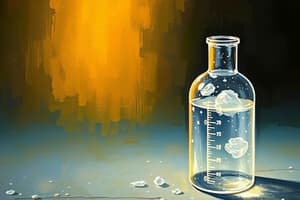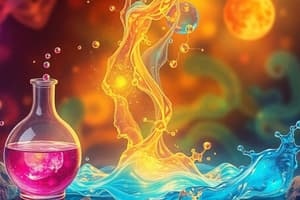Podcast
Questions and Answers
What happens when an Arrhenius acid is dissolved in water?
What happens when an Arrhenius acid is dissolved in water?
- It dissociates into a positive ion
- It forms a hydronium ion by donating a hydrogen ion to the water (correct)
- It donates a hydroxide ion to the water
- It accepts a hydrogen ion from the water
Which of the following is NOT a characteristic of Arrhenius acids?
Which of the following is NOT a characteristic of Arrhenius acids?
- Lower the pH of a solution
- Contain hydrogen as the first element
- Form hydronium ions in water
- Form hydroxide ions when dissolved in water (correct)
Why is it a misconception that any compound containing hydrogen is an Arrhenius acid?
Why is it a misconception that any compound containing hydrogen is an Arrhenius acid?
- Because they have a neutral pH
- Because hydrogen ions need to dissociate to form hydronium ions (correct)
- Because they release hydroxide ions
- Because such compounds are always alkaline
Which of the following compounds is listed as a common Arrhenius acid?
Which of the following compounds is listed as a common Arrhenius acid?
What effect does an Arrhenius acid have on the overall hydronium ion concentration of a solution?
What effect does an Arrhenius acid have on the overall hydronium ion concentration of a solution?
Which element is typically listed first in the chemical formula of Arrhenius acids?
Which element is typically listed first in the chemical formula of Arrhenius acids?
What does an Arrhenius Base produce when dissociated in water?
What does an Arrhenius Base produce when dissociated in water?
What is a key characteristic of Arrhenius acids?
What is a key characteristic of Arrhenius acids?
Why doesn't a compound lacking hydrogen ions qualify as an Arrhenius acid?
Why doesn't a compound lacking hydrogen ions qualify as an Arrhenius acid?
What is a common characteristic of Arrhenius bases?
What is a common characteristic of Arrhenius bases?
Which compound would NOT be classified as an Arrhenius base based on its composition?
Which compound would NOT be classified as an Arrhenius base based on its composition?
What is the main limitation of the Arrhenius model for defining acids and bases?
What is the main limitation of the Arrhenius model for defining acids and bases?
In an Arrhenius acid-base reaction, what are the typical products when HF reacts with LiOH?
In an Arrhenius acid-base reaction, what are the typical products when HF reacts with LiOH?
What is the key factor in determining whether a compound qualifies as an Arrhenius acid?
What is the key factor in determining whether a compound qualifies as an Arrhenius acid?
Which of the following compounds is NOT classified as a common Arrhenius acid?
Which of the following compounds is NOT classified as a common Arrhenius acid?
What ion is produced when an Arrhenius Base dissociates in water?
What ion is produced when an Arrhenius Base dissociates in water?
Why is it a misconception that any compound containing hydrogen will act as an Arrhenius acid?
Why is it a misconception that any compound containing hydrogen will act as an Arrhenius acid?
What effect does the donation of a hydrogen ion from an Arrhenius acid have on the pH of a solution?
What effect does the donation of a hydrogen ion from an Arrhenius acid have on the pH of a solution?
Which characteristic distinguishes an Arrhenius Base from an Arrhenius Acid?
Which characteristic distinguishes an Arrhenius Base from an Arrhenius Acid?
Which common misconception is addressed in the text regarding identifying Arrhenius acids?
Which common misconception is addressed in the text regarding identifying Arrhenius acids?
Which of the following compounds would NOT be classified as an Arrhenius acid?
Which of the following compounds would NOT be classified as an Arrhenius acid?
What is a distinguishing characteristic of Arrhenius bases?
What is a distinguishing characteristic of Arrhenius bases?
In an Arrhenius acid-base reaction, what are the typical products when H2SO4 reacts with NaOH?
In an Arrhenius acid-base reaction, what are the typical products when H2SO4 reacts with NaOH?
What is a limitation of the Arrhenius model in defining acids and bases?
What is a limitation of the Arrhenius model in defining acids and bases?
Which of the following compounds would NOT qualify as an Arrhenius base based on its composition?
Which of the following compounds would NOT qualify as an Arrhenius base based on its composition?
'Tastes soapy' and 'turns litmus paper blue' are common properties associated with which type of substance?
'Tastes soapy' and 'turns litmus paper blue' are common properties associated with which type of substance?
Which of the following compounds falls under the category of Arrhenius acids?
Which of the following compounds falls under the category of Arrhenius acids?
'Feels slippery to the touch' is a property associated with which of the following?
'Feels slippery to the touch' is a property associated with which of the following?
Flashcards are hidden until you start studying
Study Notes
Arrhenius Acid and Base
- An Arrhenius acid is a substance that donates a hydrogen ion to water, forming a hydronium ion, which increases the hydronium ion concentration and lowers the pH of the solution.
- An Arrhenius base is a substance that forms a hydroxide ion when dissociated in water.
Arrhenius Acid List
- Common Arrhenius acids:
- Hydrochloric acid (HCl)
- Sulfuric acid (H2SO4)
- Nitric acid (HNO3)
- Phosphoric acid (H3PO4)
- Hydrofluoric acid (HF)
- Hydrobromic acid (HBr)
- Carbonic acid (H2CO3)
- Acetic acid (HCH3CO2)
- Hypochlorous acid (HClO)
- Hydroiodic acid (HI)
- Hydrosulfuric acid (H2S)
- Phosphorus acid (H3PO3)
Arrhenius Base List
- Common Arrhenius bases:
- Sodium hydroxide (NaOH)
- Potassium hydroxide (KOH)
- Magnesium hydroxide (Mg(OH)2)
- Lithium hydroxide (LiOH)
- Aluminum hydroxide (Al(OH)3)
- Calcium hydroxide (Ca(OH)2)
- Beryllium hydroxide (Be(OH)2)
- Copper (II) hydroxide (Cu(OH)2)
- Iron (I) hydroxide (FeOH)
- Cobalt (I) hydroxide (CoOH)
Properties of Arrhenius Acid and Base
- Arrhenius acids:
- React with bases
- pH values between 0 and 7
- Taste and smell sour
- Turn litmus paper red
- Arrhenius bases:
- Feel slippery to the touch
- Taste soapy
- pH values greater than 7
- Turn litmus paper blue
Limitations of Arrhenius Model
- Water must be present for a substance to qualify as an Arrhenius acid or base.
- Acids and bases can exist in situations where water is not present.
- The definition has limitations in certain circumstances, such as when a compound is dissolved in a solvent other than water.
Studying That Suits You
Use AI to generate personalized quizzes and flashcards to suit your learning preferences.




